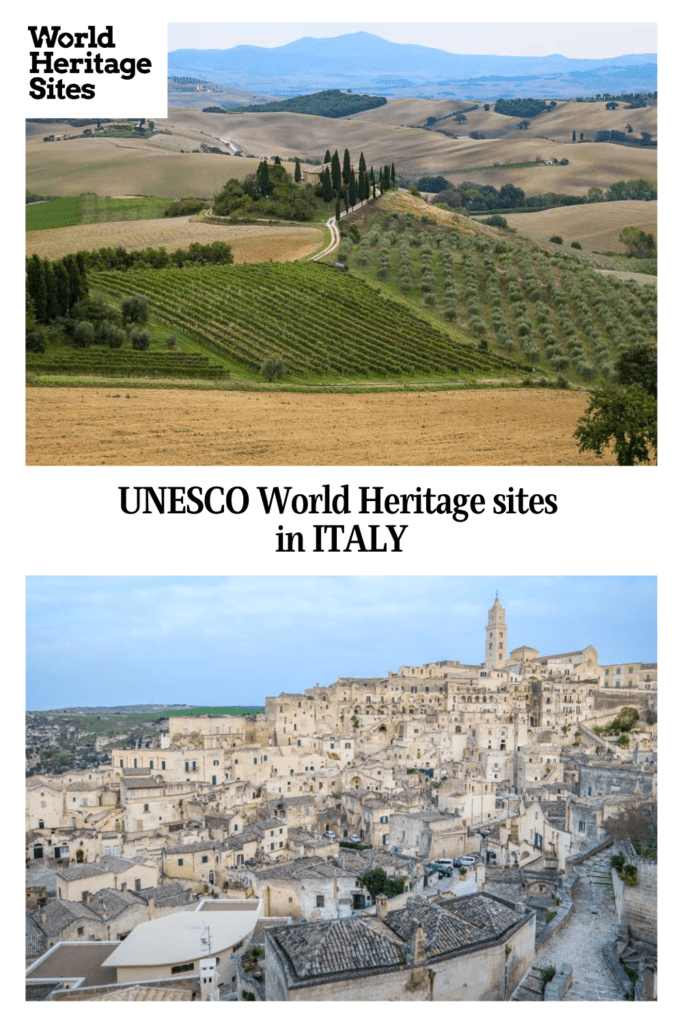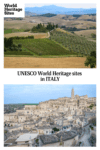Italy
It is perhaps not surprising that Italy – home of the Roman Empire, birthplace of the Renaissance, historical hub of sea trade in the Mediterranean and the world – has more UNESCO sites than any other. Use the map to jump to each site’s page – zoom as needed, or make the map full-screen. Alternatively, use the list of sites below the map.
SEE ALSO: San Marino and Holy See.
Apulia
The Trulli of Alberobello
Picturesque whitewashed houses with conical roofs, built using age-old dry-stone techniques.
Castel del Monte
An unusual castle expressing Frederick II’s search for perfection, leading him to design the castle around the number 8.
Basilicata
The Sassi and the Park of the Rupestrian Churches of Matera
More than 1000 cave dwellings, churches and other rock-cut structures going back centuries.
Campania
Costiera Amalfitana
A scenic and dramatic landscape of rugged mountainous coastline and small towns crowding the slopes above the sea.
Historic Centre of Naples
An ancient Italian city containing a wealth of elements – architecture, art, archeology – displaying its long history.
Archaeological Areas of Pompei, Herculaneum and Torre Annunziata
The remarkably-preserved remains of ancient Roman cities destroyed in a sudden eruption of Mount Vesuvius.
18th-Century Royal Palace at Caserta with the Park, the Aqueduct of Vanvitelli, and the San Leucio Complex
Cilento and Vallo di Diano National Park with the Archeological Sites of Paestum and Velia, and the Certosa di Padula
Emilia-Romagna
The Porticoes of Bologna
An architectural element that, over centuries, has become an integral part of life in Bologna and around the world.
Cathedral, Torre Civica and Piazza Grande, Modena
Romanesque architecture and art in harmony, in a charming Italian city.
Ferrara, City of the Renaissance, and its Po Delta
Early Christian Monuments of Ravenna
Friuli-Venezia Giulia
Archaeological Area and the Patriarchal Basilica of Aquileia
Lazio
Villa Adriana (Tivoli)
A lavish retreat built for Roman emperor Hadrian in the 2nd century.
Villa d’Este, Tivoli
A 16th-century villa with a garden that epitomizes the Renaissance aesthetic in garden design.
Etruscan Necropolises of Cerveteri and Tarquinia
Historic Centre of Rome, the Properties of the Holy See in that City Enjoying Extraterritorial Rights and San Paolo Fuori le Mura
Also see: Holy See
Liguria
Genoa: Le Strade Nuove and the system of the Palazzi dei Rolli
A group of private Baroque palaces used by government in the 16th-17th-century to house visiting dignitaries.
Portovenere, Cinque Terre, and the Islands (Palmaria, Tino and Tinetto)
Lombardy
Crespi d’Adda
A 19th-century company town built to provide a good standard of living for employees of a cotton mill.
Mantua and Sabbioneta
Church and Dominican Convent of Santa Maria delle Grazie with “The Last Supper” by Leonardo da Vinci
Rock Drawings in Valcamonica
Marche
Historic Centre of Urbino
Piedmont
Residences of the Royal House of Savoy
A series of palaces and estates in and around Turin that exemplify baroque architecture.
Vineyard Landscape of Piedmont: Langhe-Roero and Monferrato
A region of northern Italy representing excellence in winegrowing and winemaking.
Ivrea, industrial city of the 20th century
Sardinia
Su Nuraxi di Barumini
Ruins of a Bronze Age society that built unique circular defensive structures.
Sicily
Archaeological Area of Agrigento
An exceptional collection of ancient Greek temples dating to the 5th century BC.
Mount Etna
An ancient and still active volcano, influential in the sciences of volcanology and geology.
Villa Romana del Casale
The ruins of a Roman villa with remarkably well-preserved mosaics.
Arab-Norman Palermo and the Cathedral Churches of Cefalú and Monreale
Sicilian landmarks that showcase a blend of Arab, Norman and Byzantine influences in art and architecture.
Syracuse and the Rocky Necropolis of Pantalica
A city with the traces of three thousand years of civilization.
Late Baroque Towns of the Val di Noto (South-Eastern Sicily)
Eight Sicilian towns that were rebuilt in a distinctive Late Baroque style after a 1693 earthquake.
Isole Eolie (Aeolian Islands)
Tuscany
Piazza del Duomo, Pisa
Four masterpieces of Pisan Romanesque architecture, including the world-famous Leaning Tower.
Historic Centre of San Gimignano
A charming medieval town known for its tall towers and Sienese Gothic artworks.
Val d’Orcia
A beautiful agrarian landscape reflecting a Renaissance aesthetic.
Historic Centre of Florence
Historic Centre of the City of Pienza
Historic Centre of Siena
Medici Villas and Gardens in Tuscany
Umbria
Assisi, the Basilica of San Francesco and Other Franciscan Sites
Veneto
Le Colline del Prosecco di Conegliano e Valdobbiadene
A uniquely beautiful landscape of hills and valleys, with vineyards and wineries producing world-famous Prosecco wines.
Venice and its Lagoon
An immense collection of art and architecture in this “floating” city of canals and islands.
City of Verona
A city exemplifying 2000 years of uninterrupted artistic and architectural development.
City of Vicenza and the Palladian Villas of the Veneto
A collection of 16th-century architecture designed by Andrea Palladio in what is now known as Palladian style.
Botanical Garden (Orto Botanico), Padua
Padua’s fourteenth-century fresco cycles
Venetian Works of Defence between the 16th and 17th Centuries: Stato da Terra – Western Stato da Mar
Multiple regions
The Dolomites
Longobards in Italy. Places of the Power (568-774 A.D.)
Sacri Monti of Piedmont and Lombardy
Evaporitic Karst and Caves of Northern Apennines
Via Appia. Regina Viarum
Transnational sites
The Great Spa Towns of Europe
Towns in seven countries where an early tourism industry thrived around natural hot springs.
Ancient and Primeval Beech Forests of the Carpathians and Other Regions of Europe
Forests of European beech trees that survived the last Ice Age and then spread across Europe, now protected in 93 locations across 18 countries.
Rhaetian Railway in the Albula / Bernina Landscapes
A railway route through the Swiss Alps that represents an outstanding early-20th-century engineering and architectural achievement.
Monte San Giorgio
Prehistoric Pile Dwellings around the Alps


